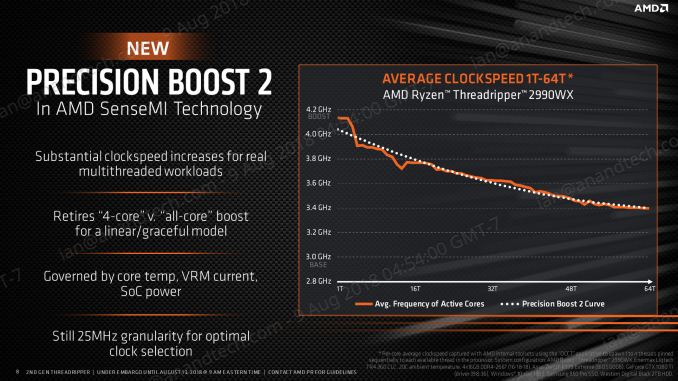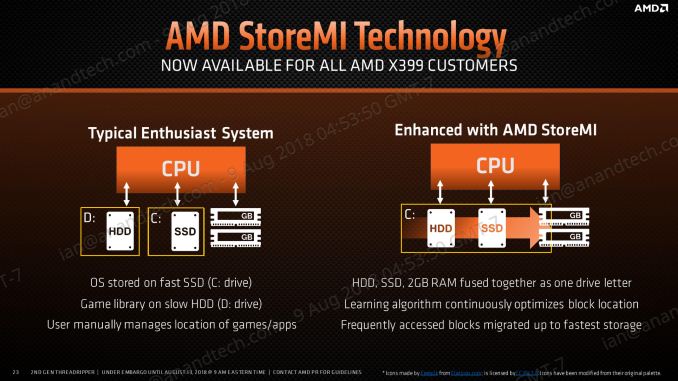The AMD Threadripper 2990WX 32-Core and 2950X 16-Core Review
by Dr. Ian Cutress on August 13, 2018 9:00 AM ESTPrecision Boost 2
Exact per-core turbo timings for the new processors will be determined by AMD’s voltage-frequency scaling functionality through Precision Boost 2. This feature, which we covered extensively in our Ryzen 7 2700X review, relies on available power and current to determine frequency, rather than a discrete look-up-table for voltage and frequency based on loading. Depending on the system default capabilities, the frequency and voltage will dynamically shift in order to use more of the power budget available at any point in the processor loading.
The idea is that the processor can use more of the power budget available to it than a fixed look up table that has to be consistent between all SKUs that are stamped with that number.
Precision Boost 2 also works in conjunction with XFR2 (eXtreme Frequency Range) which reacts to additional thermal headroom. If there is additional thermal budget, driven by a top-line cooler, then the processor is enabled to use more power up to the thermal limit and get additional frequency. AMD claims that a good cooler in a low ambient situation can compute >10% better in selected tests as a result of XFR2.
Ultimately this makes testing Threadripper 2 somewhat difficult. With a turbo table, performance is fixed between the different performance characteristics of each bit of silicon, making power the only differentiator. With PB2 and XF2, no two processors will perform the same. AMD has also hit a bit of a snag with these features, choosing to launch Threadripper 2 during the middle of a heatwave in Europe. Europe is famed for its lack of air conditioning everywhere, and when the ambient temperature is going above 30ºC, this will limit additional performance gains. It means that a review from a Nordic publication might see better results than one from the tropics, quite substantially.
Luckily for us we tested most of our benchmarks while in an air conditioned hotel thanks to Intel’s Data-Centric Innovation Summit which was the week before launch.
Precision Boost Overdrive
The new processors also support a feature called Precision Boost Overdrive, which looks at three key areas for power, thermal design current, and electrical design current. If any of these three areas has additional headroom, then the system will attempt to raise both the frequency and the voltage for increased performance. PBO is a mix of ‘standard’ overclocking, giving an all core boost, but gives a single core frequency uplift along with the support to still keep Precision Boost trying to raise frequency in middle-sized workloads, which is typically lost with a standard overclock. PBO also allows for idle power saving with a standard performance. PBO is enabled through Ryzen Master.
The three key areas are defined by AMD as follows:
- Package (CPU) Power, or PPT: Allowed socket power consumption permitted across the voltage rails supplying the socket
- Thermal Design Current, or TDC: The maximum current that can be delivered by the motherboard voltage regulator after warming to a steady-state temperature
- Electrical Design Current, or EDC: The maximum current that can be delivered by the motherboard voltage regulator in a peak/spike condition
By extending these limits, PBO gives rise for PB2 to have more headroom, letting PB2 push the system harder and further. PBO is quoted by AMD as supplying up to +16% performance beyond the standard.
AMD also clarifies that PBO is pushing the processor beyond the rated specifications and is an overclock: and thus any damage incurred will not be protected by warranty
StoreMI
Also available with the new Ryzen Threadripper 2 processors is StoreMI, AMD’s solution to caching by offering configurable tiered storage for users that want to mix DRAM, SSD, and HDD storage into a single unified platform. The software implementation dynamically adjusts data between up to 2GB of DRAM, up to 256 GB of SSD (NVMe or SATA), and a spinning hard drive to afford the best reading and writing experience when there isn’t enough fast storage.
AMD initially offered this software as a $20 add-on to the Ryzen APU platform, then it became free (up to a 256GB SSD) for the Ryzen 2000-series processors. That offer now extends to Threadripper. AMD’s best case scenario is citing a 90% improvement in loading times.













171 Comments
View All Comments
Ian Cutress - Monday, August 13, 2018 - link
It looks like the 2950X are reversed (C++ should be OpenCL), but I checked the raw data and that's what came out of the benchmark. I need to put the 2950X back on to test, I'll do it in a bitStuka87 - Monday, August 13, 2018 - link
Thanks for getting this up Ian! An awesome read per usual :)deathBOB - Monday, August 13, 2018 - link
The interconnect analysis was very interesting, glad you spent time on that.mapesdhs - Monday, August 13, 2018 - link
Yes, that was good. I had flashbacks to reading SGI Origin technical reports 20 years ago. :Dhttp://www.sgidepot.co.uk/origin/isca.pdf
http://www.sgidepot.co.uk/origin/hypercube.pdf
Index: http://www.sgidepot.co.uk/origin/
I see a great many similarities, though the emphasis is different (SGI was all about bandwidth rather than latency, for extreme I/O and huge datasets in shared memory, though they greatly improved the latency behaviour with the 2nd-gen design). Fascinating to see many of the same issues play out in the consumer space, but for rather different tasks, though I bet a lot of researchers in industry and academia will be taking keen interest in what AMD has released.
close - Monday, August 13, 2018 - link
"They will enable four cores per complex (8+8+8+8) and three cores per complex (6+6+6+6)"3/4 cores per complex or 6/8 cores?
MrSpadge - Monday, August 13, 2018 - link
The 8 cores per die are distributed over 2 CCX core complexes with 4 cores each, as in Ryzen 1.FreckledTrout - Monday, August 13, 2018 - link
LOL You actually ran tests with the plastic on? That is just funny. Did the plastic melt?Ian Cutress - Monday, August 13, 2018 - link
It ran fine, though the numbers suggest the thermals reduced PB2/XFR2 turbo by a fair bit. Some tests look a bit down. Still writing it up :)FreckledTrout - Tuesday, August 14, 2018 - link
Hilarious. That does sound like something I would do in a hurry. I see you have a whole section awaiting for plastic vs no plastic thermals. I bet that will be an Anandtech only talking point. :)msroadkill612 - Thursday, August 16, 2018 - link
A coredom?